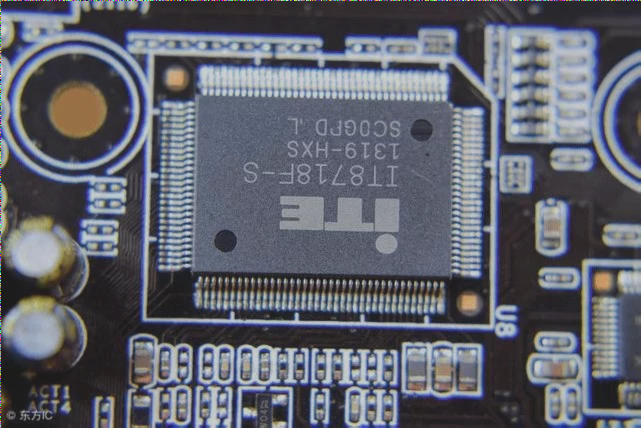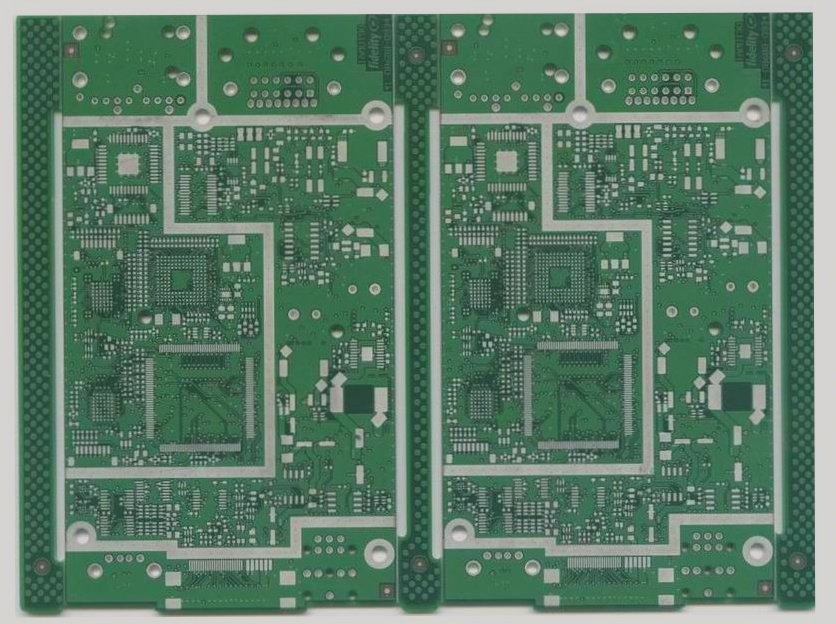1. Abrasives and Brushes
Various materials are used for pre-cleaning the PCB board surface and brushing the copper surface, such as polymer non-woven fabrics, non-woven fabrics mixed with emery, or various types of sand-free materials, and pumice powder (Pumice Slurry), etc. These materials are collectively referred to as abrasives. However, brushes made with sand particles can sometimes leave residue on the copper surface, leading to issues with adhesion and solderability of subsequent layers like photoresist or electroplating. The diagram below illustrates the fibers of the brush material mixed with sand particles.

2. Air Knife
At the outlet of various online process units, there is often an air knife that blows high-temperature and high-pressure air to quickly dry the board surface, making it easier to handle and reducing the risk of oxidation.
3. Anti-Foaming Agent
Foam can be a common issue during the PCB manufacturing process, especially in processes like washing the dry film developer. Chemicals need to be added to reduce surface tension in the bath, such as Octyl Alcohol or Silicone defoamers, to improve operations. It is crucial to avoid silicone resins containing cationic interface active agents of silicon oxide compounds, as they can lead to poor adhesion or solderability on metal surfaces like copper.
4. Bondability Bonding Layer
The surface to be bonded must maintain good cleanliness to ensure strong bonding, known as “bonding.”
5. Banking Agent
Organic additives added to etching solutions can enhance film adhesion on weak water flow sides of lines, reducing lateral erosion and promoting fine line etching. The formulation of this agent is typically proprietary.
6. Bright-Dip Gloss Dipping Treatment
A treatment that slightly smoothens and brightens the metal surface. The wet bath process is known as “bright-dip.”
7. Chemical Milling
A method that selectively corrodes metal surfaces using chemical baths instead of mechanical punching. Also called Chemical Blanking or Photo Chemical Machining (PCM), this technology saves costs, time, and eliminates residual stress.
8. Coat, Coating Film, Surface Layer
Refers to any treatment layer applied to the board surface.
9. Conversion Coating
Allows for the formation of protective compounds on metal surfaces through specific baths. Enhances adhesion and corrosion resistance.
10. Degreasing
Not typically needed in PCB processes due to minimal exposure to oils. However, a “clean” treatment is still necessary for pre-treating boards.
11. Etch Factor
An important indicator for etching quality, it can refer to either the positive etch depth to side etch concave ratio (American definition) or the opposite (European definition).
12. Etchant
Chemical baths used for etching copper layers. Different solutions are used for inner-layer and outer-layer boards to improve copper corrosion quality.
13. Etching Indicator
A special pattern used to monitor etching levels. Helps improve the etching process.
14. Etching Resist
The protective film layer on copper conductors to prevent corrosion during etching. Materials like image transfer photoresist or dry film are commonly used.
15. Hard Anodizing
A process that creates a hard, decorative, and anti-corrosive surface on aluminum using an anodized film.
16. Hard Chrome Plating
A wear-resistant chrome plating used in industrial applications for longevity and lubrication. Requires careful handling due to hydrogen generation and waste water pollution.
17. Mass Finishing
A polishing method for small metal products before electroplating to achieve a smooth base for plating.
18. Microetching
A wet process step in PCB manufacturing to clean copper surfaces and prepare for further processing.
19. Mouse Bite
Irregular gaps on copper lines after etching. A term gaining popularity in the U.S. PCB industry.
20. Overflow
When liquid in a tank rises above the tank wall edge and flows out, it’s called overflow. Helps save water during the wet process.
21. Panel Process
A method used to manufacture circuit boards by direct etching to obtain outer layer circuits. Simplifies the process but may be challenging for thin lines.
22. Passivation
A metal surface treatment method using nitric acid and chromic acid to form a thin oxide film for protection.
23. Pattern Process
A manufacturing method for PCBs using negative image transfer and secondary plating for copper corrosion resistance.
24. Puddle Effect
The formation of a water film on the upward board surface during horizontal transport, hindering the etching process.
25. Reverse Current Cleaning
An anodic electrolytic cleaning method using electrolysis to remove impurities from metal surfaces.
26. Rinsing
Cleaning transitional sections between wet process tanks to prevent chemical interference and ensure treatment quality.
27. Sand Blast
A surface cleaning method using high-speed particles blown onto an object for rust removal or dirt removal.
28. Satin Finish
A surface treatment method for achieving a semi-gloss luster on metal surfaces.
29. Scrubber
Equipment used for grinding, polishing, and cleaning board surfaces in a circuit board industry.
30. Sealing
A process to enhance the durability of an anodized aluminum surface by immersing it in hot water.
31. Sputtering
A coating method using high-voltage conditions to force metal atoms onto a workpiece surface for a uniform film layer.
32. Stripper
A liquid used for stripping metal plating or organic films during PCB manufacturing.
33. Surface Tension
The inward attraction on the surface of a liquid, causing cohesive forces that affect spreading.
34. Surfactant
Chemicals added to bath solutions to reduce surface tension and assist in wetting through holes.
35. Ultrasonic Cleaning
Using ultrasonic energy to generate foam for cleaning objects, particularly effective for removing dirt from hard-to-reach areas.
36. Undercut
Lateral corrosion occurring during the etching process, leading to indentation on the copper line cross-section.
37. Water Break
A method of checking board cleanliness by observing the behavior of water droplets on the surface.
38. Wet Blasting
Physical cleaning method using high-pressure air and wet abrasives to remove dirt from metal surfaces in the PCB board manufacturing process.
Various materials are used for pre-cleaning the PCB board surface and brushing the copper surface, such as polymer non-woven fabrics, non-woven fabrics mixed with emery, or various types of sand-free materials, and pumice powder (Pumice Slurry), etc. These materials are collectively referred to as abrasives. However, brushes made with sand particles can sometimes leave residue on the copper surface, leading to issues with adhesion and solderability of subsequent layers like photoresist or electroplating. The diagram below illustrates the fibers of the brush material mixed with sand particles.

2. Air Knife
At the outlet of various online process units, there is often an air knife that blows high-temperature and high-pressure air to quickly dry the board surface, making it easier to handle and reducing the risk of oxidation.
3. Anti-Foaming Agent
Foam can be a common issue during the PCB manufacturing process, especially in processes like washing the dry film developer. Chemicals need to be added to reduce surface tension in the bath, such as Octyl Alcohol or Silicone defoamers, to improve operations. It is crucial to avoid silicone resins containing cationic interface active agents of silicon oxide compounds, as they can lead to poor adhesion or solderability on metal surfaces like copper.
4. Bondability Bonding Layer
The surface to be bonded must maintain good cleanliness to ensure strong bonding, known as “bonding.”
5. Banking Agent
Organic additives added to etching solutions can enhance film adhesion on weak water flow sides of lines, reducing lateral erosion and promoting fine line etching. The formulation of this agent is typically proprietary.
6. Bright-Dip Gloss Dipping Treatment
A treatment that slightly smoothens and brightens the metal surface. The wet bath process is known as “bright-dip.”
7. Chemical Milling
A method that selectively corrodes metal surfaces using chemical baths instead of mechanical punching. Also called Chemical Blanking or Photo Chemical Machining (PCM), this technology saves costs, time, and eliminates residual stress.
8. Coat, Coating Film, Surface Layer
Refers to any treatment layer applied to the board surface.
9. Conversion Coating
Allows for the formation of protective compounds on metal surfaces through specific baths. Enhances adhesion and corrosion resistance.
10. Degreasing
Not typically needed in PCB processes due to minimal exposure to oils. However, a “clean” treatment is still necessary for pre-treating boards.
11. Etch Factor
An important indicator for etching quality, it can refer to either the positive etch depth to side etch concave ratio (American definition) or the opposite (European definition).
12. Etchant
Chemical baths used for etching copper layers. Different solutions are used for inner-layer and outer-layer boards to improve copper corrosion quality.
13. Etching Indicator
A special pattern used to monitor etching levels. Helps improve the etching process.
14. Etching Resist
The protective film layer on copper conductors to prevent corrosion during etching. Materials like image transfer photoresist or dry film are commonly used.
15. Hard Anodizing
A process that creates a hard, decorative, and anti-corrosive surface on aluminum using an anodized film.
16. Hard Chrome Plating
A wear-resistant chrome plating used in industrial applications for longevity and lubrication. Requires careful handling due to hydrogen generation and waste water pollution.
17. Mass Finishing
A polishing method for small metal products before electroplating to achieve a smooth base for plating.
18. Microetching
A wet process step in PCB manufacturing to clean copper surfaces and prepare for further processing.
19. Mouse Bite
Irregular gaps on copper lines after etching. A term gaining popularity in the U.S. PCB industry.
20. Overflow
When liquid in a tank rises above the tank wall edge and flows out, it’s called overflow. Helps save water during the wet process.
21. Panel Process
A method used to manufacture circuit boards by direct etching to obtain outer layer circuits. Simplifies the process but may be challenging for thin lines.
22. Passivation
A metal surface treatment method using nitric acid and chromic acid to form a thin oxide film for protection.
23. Pattern Process
A manufacturing method for PCBs using negative image transfer and secondary plating for copper corrosion resistance.
24. Puddle Effect
The formation of a water film on the upward board surface during horizontal transport, hindering the etching process.
25. Reverse Current Cleaning
An anodic electrolytic cleaning method using electrolysis to remove impurities from metal surfaces.
26. Rinsing
Cleaning transitional sections between wet process tanks to prevent chemical interference and ensure treatment quality.
27. Sand Blast
A surface cleaning method using high-speed particles blown onto an object for rust removal or dirt removal.
28. Satin Finish
A surface treatment method for achieving a semi-gloss luster on metal surfaces.
29. Scrubber
Equipment used for grinding, polishing, and cleaning board surfaces in a circuit board industry.
30. Sealing
A process to enhance the durability of an anodized aluminum surface by immersing it in hot water.
31. Sputtering
A coating method using high-voltage conditions to force metal atoms onto a workpiece surface for a uniform film layer.
32. Stripper
A liquid used for stripping metal plating or organic films during PCB manufacturing.
33. Surface Tension
The inward attraction on the surface of a liquid, causing cohesive forces that affect spreading.
34. Surfactant
Chemicals added to bath solutions to reduce surface tension and assist in wetting through holes.
35. Ultrasonic Cleaning
Using ultrasonic energy to generate foam for cleaning objects, particularly effective for removing dirt from hard-to-reach areas.
36. Undercut
Lateral corrosion occurring during the etching process, leading to indentation on the copper line cross-section.
37. Water Break
A method of checking board cleanliness by observing the behavior of water droplets on the surface.
38. Wet Blasting
Physical cleaning method using high-pressure air and wet abrasives to remove dirt from metal surfaces in the PCB board manufacturing process.




